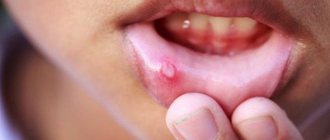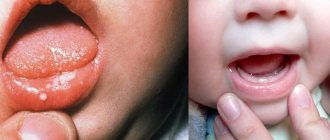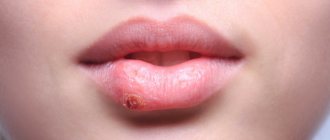Causes and risk factors
The mucous membrane of the child's oral cavity is often injured. The appearance of ulcers can be caused by temperature effects (hot food and drinks), biting the inner surface of the cheeks or lips; damage by sharp edges of the filling, braces or the tooth’s own tissues in case of chipped enamel. Normally, the immune response allows the pathological process to be quickly eliminated, the mucous membrane heals, and bacteria do not have time to cause severe inflammation and ulceration.
Weakened children's immunity cannot cope with this task, which leads to the development of aphthous stomatitis. A small number of opportunistic bacteria that populate the oral cavity begin to actively multiply. Often the disease occurs against the background or as a result of a severe infection: influenza, ARVI, acute tonsillitis, infectious mononucleosis, etc.
Main risk factors:
- food allergies, allergic reactions to hygiene products, such as toothpaste;
- deficiency of vitamins and microelements due to a strict diet or impaired digestion of food;
- hereditary predisposition;
- foci of infection in the oral cavity: caries, chronic periodontitis, periodontitis, gingivitis;
- frequent respiratory diseases;
- severe systemic diseases: pathologies of the endocrine system, blood vessels, metabolic disorders, etc.
Ask a Question
Causes
- Malfunctions of the immune system
- Diseases of the gastrointestinal tract
- Hereditary factor
- Allergies to certain foods and medications
- Avitaminosis
- Unbalanced diet (lack of vitamin B12, folic acid, iron in the diet)
- Tonsillitis, sore throat, pharyngitis
- Local infection with pathogenic microflora (from diseased teeth and gums or from external sources)
- Injury to the mucous membrane (burns, biting, injuries from sharp edges of fillings or braces, etc.)
Forms of the disease
According to the ICD, aphthous stomatitis is assigned code K12.0. There are two forms of the disease - acute and chronic. The second is characterized by frequent relapses and may be a consequence of inadequate or untimely treatment of acute inflammation.
An acute disease is characterized by severe symptoms. It begins quickly, severe pain occurs at the site of mucosal damage, and the child may refuse to eat. In some cases, body temperature rises, weakness and lethargy occur.
The chronic form is characterized by a sluggish course; the child’s general well-being does not suffer. The disease can recur up to several times a year.
Symptoms
The disease has rather sparse symptoms. Visually, it is easy to identify by the presence of characteristic ulcers on the inside of the lips, cheeks, soft palate and tongue (rarely). Keratinized (fixed) gums are not affected by aphthous stomatitis, which is another difference between aphthous stomatitis and herpetic stomatitis. At the initial stage of aphthae, the patient usually feels discomfort and burning, and the temperature may rise slightly. Diagnosis involves a visual examination, as well as taking blood tests and mucosal smears if the doctor suspects the presence of concomitant diseases.
Symptoms of aphthous stomatitis
The onset of acute aphthous stomatitis in children may resemble ARVI: there is malaise, increased body temperature, and more profuse salivation may appear. The main symptom of the disease is the appearance of ulcers in the mouth: first, a red dot appears on the mucous membrane, which subsequently becomes an ulcer (aphtha) within 2-3 days. Accidental touching causes pain. The child refuses food and hygiene procedures.
Single erosions occur more often, but there are cases of multiple aphthae formed in groups. They usually measure up to several millimeters, but in severe cases the diameter of the ulcer reaches one centimeter. The disease is characterized by the appearance of a bright red rim around the aphthae; a grayish or yellow film-like coating forms on it.
There are also general symptoms that accompany aphthous stomatitis. These include:
- sleep disturbances (due to pain or discomfort);
- decreased appetite;
- pain while talking;
- increased fatigue, lethargy;
- whims, irritability.
Early treatment of aphthous stomatitis in children can prevent complications, shorten recovery time, and prevent further development of the disease.
Diagnostics
If a mucosal lesion occurs in the mouth, the patient is examined by a dentist, infectious disease specialist or pediatrician. To identify the cause of the disease, measures are taken to identify the causative agent of the disease.
The following diagnostic methods are used:
- linked immunosorbent assay;
- cytopolymerase reaction;
- tank sowing discharge from ulcers, pieces of mucous membrane and plaque;
- cytological, immunological research methods.
If candidal stomatitis is suspected, an endocrinologist is consulted and tests are performed to detect diabetes mellitus.
In chronic forms of the disease, the following is carried out:
- tests for worm eggs;
- Ultrasound of the abdominal area;
- immunogram;
- stool examination for dysbacteriosis.
Consultations with a gastroenterologist and immunologist are carried out.
Features of treatment
To diagnose a disease, only a visual examination is often sufficient, but in some cases laboratory diagnostics are required to determine the causative agent of the inflammatory process and the sensitivity of bacteria to antibiotics. Treatment should be carried out by a dentist, and the treatment regimen is developed individually, taking into account test results, the age and well-being of the child, the causes of the disease, the area of mucosal lesions and other conditions.
If the question of how to treat aphthous stomatitis in children is decided individually, then recommendations regarding eating behavior and hygiene are general for all cases. Such recommendations include the following:
- avoidance of too hot or cold drinks and foods;
- following a hypoallergenic diet;
- refusal of food that irritates the mucous membrane. This list includes fatty, salty and spicy foods, marinades, solid foods;
- adding pureed and soft foods to the menu. This includes cream soups, porridges, pre-boiled meat;
- drinking enough liquid;
- careful adherence to oral hygiene: using brushes with soft bristles, rinsing the mouth after each meal.
Local drug treatment consists of the use of such agents as:
- rinses or irrigation solutions (for children who do not yet know how to rinse their mouths) with an antiseptic effect;
- ointments and gels that stimulate the restoration of mucous membranes;
- drugs for pain relief and burning sensation.
It is important to test the product before use: apply a small amount to the crook of your elbow. If there is no redness, burning, or rash, we can say there is no allergy - the product can be used for treatment.
In some cases, systemic drug therapy is indicated. Your doctor may prescribe antihistamines to combat the allergic reaction and relieve swelling. In order to increase the resistance of the child's body, immunomodulators may be recommended. The decision on the need for antibacterial therapy is made in the case of an extremely severe course of the disease, a persistent increase in body temperature, and identification of a bacterial pathogen in a smear.
Elevated body temperature and pain are indications for symptomatic therapy. The doctor may recommend non-steroidal anti-inflammatory drugs in a dosage and form appropriate to the age of the young patient. Sometimes it is advisable to use suppositories if taking the medicine in the form of a tablet or syrup causes pain or anxiety.
Treatment of infants additionally includes disinfection of toys and teethers that the baby may put in his mouth. A nursing mother should pay attention to breast hygiene: thoroughly wash her breasts after feeding using warm water and special products.
Sometimes it is advisable to use folk remedies. Thus, rinsing the mouth with chamomile can soothe inflamed mucous membranes and speed up the healing process. However, it is important to remember that such prescriptions can only complement the main course of treatment. Don't forget to consult your doctor about the possibility of using them. Some herbs are strong allergens, so it is important to ensure that you are not hypersensitive to them.
Warming, the use of honey and alcohol tinctures are prohibited, as all this can lead to a worsening of the condition and lead to serious complications. It is better not to self-medicate, but to show the child to a qualified specialist.
Treatment of aphthous stomatitis in children usually takes no more than 7–12 days. It all depends on the state of the child’s immune system, the severity of inflammation, the number and depth of ulcers.
How to treat childhood stomatitis
Once the diagnosis has been made, treatment for stomatitis should begin as soon as possible. It is necessary to keep in mind that prescribing medications yourself: the decision can only be made by a pediatrician who has information about how this or that medicine can further affect the well-being of a small patient. First of all, the doctor must prescribe a scraping to determine the type of causative agent of the disease, and a virological study: depending on this, the type of treatment is prescribed.
The duration of treatment is influenced by the advanced stage of the disease and the type of stomatitis: on average, it is possible to overcome the disease within a week, provided that the doctor’s recommendations are fully followed.
Children's stomatitis: treatment with medications
Doctors prescribe symptomatic medications, the purpose of which is to get rid of the symptoms that accompany the development of the disease.
Appointed:
- vitamin complexes to strengthen the child’s immunity as a whole;
- antiviral drugs;
- antipyretic drugs;
- gels and ointments for treating the oral cavity.
In addition, it is recommended to drink plenty of fluids and eat a diet that excludes the consumption of spicy, sour and highly salty foods.
The most commonly prescribed drugs for stomatitis are:
- Miramistin. An antifungal solution that prevents wound infection. The drug starts the process of regeneration of damaged tissues.
- Vinilin is an anesthetic with a healing effect. The medicine forms a protective film on the surface of the ulcers, protecting them from irritation when eating food, as a result of which the healing process is accelerated.
- Nystatin is an effective treatment for candidal stomatitis.
- Metrogyl Denta is an antibacterial drug applied twice a day to damaged areas of the mucous membrane.
- Acyclovir is an antiviral drug that prevents new lesions of the rash from appearing. The drug is applied up to 6 times during the day. Thanks to its use, the formation of crusts is accelerated.
Children's stomatitis: treatment with folk remedies
Many parents, in addition to or even instead of medications, prefer to use traditional medicine. As mentioned above, you should not do this without the consent of your doctor, however, you cannot fail to mention these methods of treatment.
So, among these funds it is worth highlighting:
- soda-salt solution. An equal amount of soda and salt are dissolved in a glass of water (about half a teaspoon of each component). It is recommended to rinse your mouth with the resulting solution 4 times a day after meals;
- infusion of chamomile with honey. For the solution, take a glass of boiling water and a tablespoon of chamomile. When the liquid cools, add 2 teaspoons of honey. The product is used for rinsing 3 times a day;
- brilliant green is the most affordable remedy available for sale in any pharmacy. It dries out wounds and prevents new foci of disease from forming.
Prevention
The development of the disease can be prevented with the help of general strengthening measures: it is important to adhere to a daily routine, provide nutrition taking into account the body’s needs for vitamins and minerals, and pay attention to the prevention of infectious diseases.
The development of stomatitis can be avoided using simple measures, such as:
- regular oral hygiene, which should begin from the moment the baby’s first tooth appears;
- use of toothpastes without sodium lauryl sulfate. This component increases the risk of developing the disease;
- routine examinations by a pediatric dentist;
- rinsing the mouth after every meal;
- limited consumption of sweets.
Pediatric dentists at STOMA clinics are ready to help a child of any age. By contacting us, you can be confident in the professionalism of our specialists. We have developed effective treatment regimens for aphthous stomatitis in children. Doctors will talk in detail about preventing relapses and give recommendations on maintaining oral health.
Diagnosis of the disease and its differences from other pathologies
The doctor receives the first data after examining the patient’s mouth. Next, the doctor collects an anamnesis of the disease and the patient must answer when the first symptoms appeared, how quickly the disease developed, whether there were injuries (including burns) to the oral cavity, allergies to foods and medications, whether close relatives suffered from stomatitis.
To identify the causative agent of the disease, you will need to take a smear on the flora and exclude manifestations of herpes and candidiasis. For this purpose, laboratory tests are used - bacterial culture and PCR smear.
For persistent stomatitis, you should check your blood glucose level.
Mouth treatment
The most effective measures for treating the disease are rinsing with physiological antiseptics and irrigating the oral cavity with anti-inflammatory sprays.
For treatment of the oral cavity they are used;
- miramistin solution;
- 0.06% chlorhexidine solution;
- 0.02% solution of furatsilin;
- 0.1% dimexide solution.
During therapy, it is important to select medications that provide a quick cure.
The following medications are used for therapy:
- application of anesthetics with proteolytic enzymes for 10-15 minutes once a day (trypsin, lysozyme, ribonuclease);
- applying epithelializing ointments to ulcers (Solcoseryl-gel);
- rinses with antibacterial drugs: Tantum-Verde in a dosage of 15 ml 3-4 times a day, 5-6 days or use Hexoral, Orasept;
- applications of Mundizal gel to the oral mucosa for 20 minutes 3-4 times a day, 5-10 days;
- balm Stomatofit-A, it contains painkillers, extracts of medicinal plants;
- antifungal drugs;
- painkillers, anti-inflammatory ointments (Benzocaine, Xicaine);
- Diphenhydramine suspension to relieve allergic symptoms.
Recommendations during treatment
It is very important to provide proper hygienic care for the baby during treatment. All toys must be thoroughly washed with hot water and baby or laundry soap. Wet cleaning should be carried out daily. It is best to wash the floors in the children's room with plain water, without adding disinfectants, as they often cause allergic reactions. It is necessary to ventilate the room in which the child spends most of his time at least 6 times a day. The last airing should be done before bedtime and last at least 30 minutes.
Children's dishes and bottles, as well as pacifiers and pacifiers, must be sterilized. To care for the skin, the baby must have his own towel - you cannot use towels used by other family members for this purpose, because the bacterial flora of an adult and an infant is very different.
Remedies for stomatitis in children
To speed up the healing of ulcers and the child’s recovery, you need to:
- keep plenty of fluids (breastfed children should be given breastfeeding “on demand”);
- if the child receives complementary feeding, make sure that all food is in liquid or puree form (the introduction of crackers and baby cookies into the diet should be postponed until complete recovery);
- increase the duration of daytime sleep - this will allow you to quickly restore strength and avoid overexertion, which is contraindicated for sick babies.
Feeding the baby
If, despite all the measures taken, the child’s condition does not improve after three days of treatment, it is necessary to visit the doctor again to rule out other diseases. After recovery, a preventive regimen and measures aimed at strengthening the immune system should be provided: hardening, gymnastics, frequent walks, water treatments. They must correspond to the age and physiological characteristics of the child, so before starting any health procedures it is better to consult a specialist.
Conclusions:
Aphthae in the mouth recur at some point in life in almost 20% of all people, most often in the second decade of life.
It is difficult to establish a clear and unambiguous reason.
If recurrent aphthae occurs, the pediatrician, physician, or dentist should consider the possibility that rare aphthae are a manifestation of a serious systemic disease.
In such situations, the gastroenterologist must exclude celiac disease, Crohn's disease and ulcerative colitis.
4, total, today
Folk remedies
Folk remedies are usually used during follow-up treatment, when acute manifestations are eliminated.
For the treatment of stomatitis the following is used:
- infusion of chamomile flowers;
- paste from ground burdock seeds with salt and butter;
- decoction of oak bark;
- aloe juice;
- a decoction of the rhizome of snakeweed;
- yarrow decoction;
- infusion of ground rhizome of bergenia;
- infusion of pomegranate peel.
Physiotherapeutic agents include treatment of lesions with ultraviolet rays.










